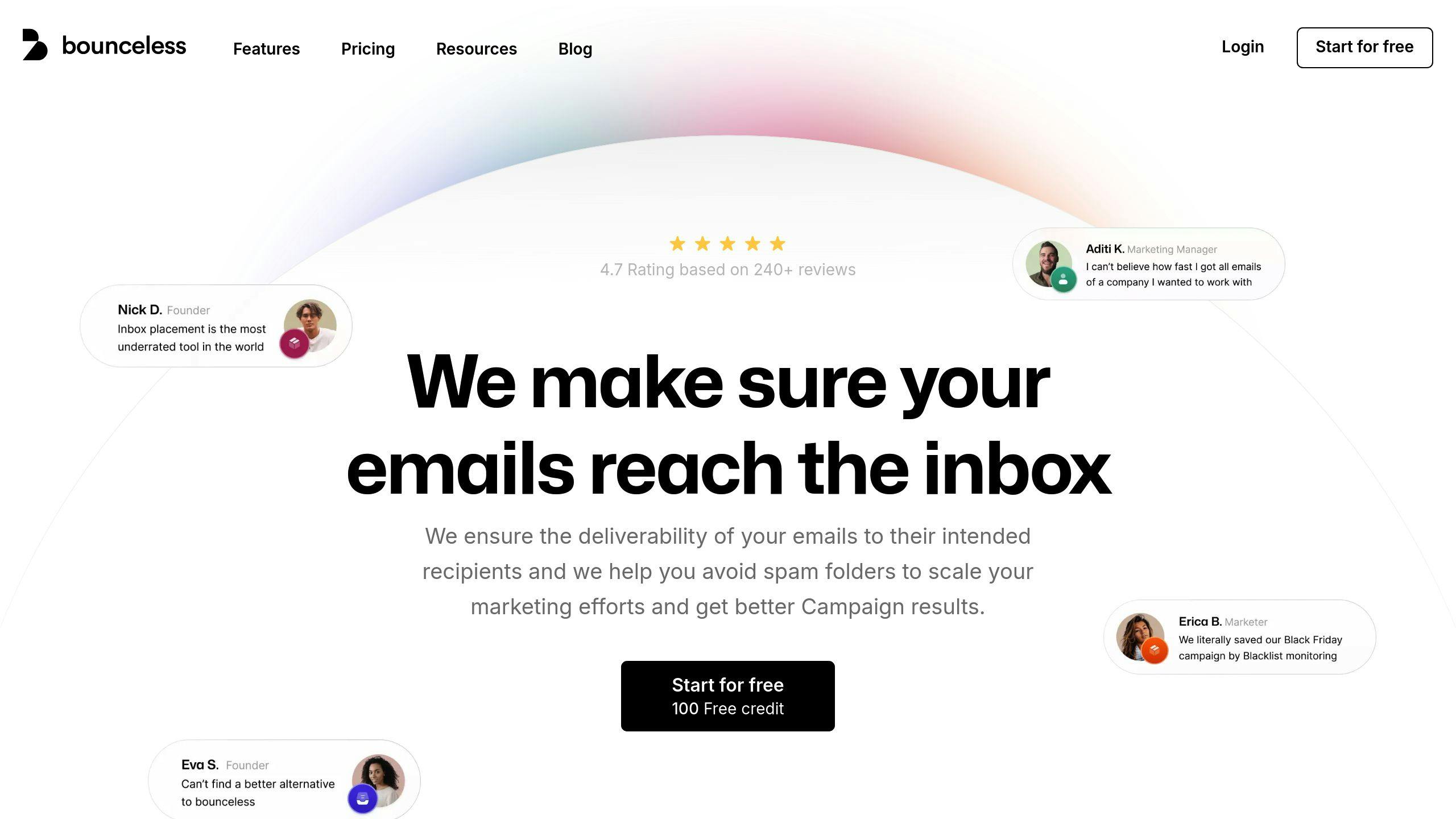Disposable email addresses are a growing problem for marketers. They harm email campaigns by increasing bounce rates, wasting resources, and skewing engagement metrics. Here's what you need to know:
- What are disposable emails? Temporary email addresses that expire quickly, often used to avoid sharing real emails.
- Why are they bad? They lead to higher bounce rates, inaccurate data, and wasted marketing efforts.
- How to combat them? Use tools like Bounceless.io to detect and remove disposable emails, implement double opt-in processes, and clean your email list regularly.
Key takeaway: Managing disposable emails is crucial to maintaining email deliverability and protecting your sender reputation.
Disposable Email Addresses and detecting them
Basics of Disposable Email Addresses
Disposable email addresses (DEAs) are temporary email accounts designed for short-term use. They typically last anywhere from a few minutes to a few hours before becoming inactive. Unlike permanent email accounts, these addresses are meant to be discarded once their purpose is fulfilled [1].
Key Features and Why Users Rely on Them
Disposable email addresses come with specific traits that align with user needs but can pose challenges for email marketers:
| Feature | Description | Impact on Marketing |
|---|---|---|
| Temporary Nature | Active for only a short period (minutes to hours) | Leads to high bounce rates |
| No Authentication | No passwords or verification required | Lowers the quality of collected leads |
| Instant Creation | Easily generated via services like 10MinuteMail or GuerrillaMail | Encourages mass signups |
| Limited Storage | Messages are deleted after expiration | Prevents tracking engagement |
| No Reply Capability | Most DEAs can't send responses | Adds zero value to contact lists |
Users turn to DEAs for several reasons:
- Privacy concerns when they don't trust a service.
- To take advantage of one-time offers like free trials, downloads, or contests.
- To bypass registration limits that restrict multiple accounts [1][2].
For marketers, these behaviors translate into challenges like inflated bounce rates and wasted resources. Identifying DEAs early through verification tools is key to protecting email list quality [1][2].
"Disposable emails are zero-value emails for your email lists. Many users are using these short-term, so it's more likely the user has abandoned a disposable email by the time you send to them." [3]
Grasping these basics is the first step in managing their impact on your deliverability metrics, which we'll dive into further in the next section.
How Disposable Emails Hurt Deliverability
Disposable email addresses create serious problems for email marketing campaigns, impacting both short-term results and long-term success. Here's how these temporary addresses can disrupt your efforts.
Higher Bounce Rates
Since disposable emails expire quickly, they often result in hard bounces. These bounces harm your sender reputation, alert email service providers (ESPs), and can even lead to blacklisting. ESPs keep a close eye on bounce rates, so high numbers can severely damage your ability to reach inboxes [1].
Inaccurate Campaign Data
Temporary emails skew your engagement metrics, making it harder to analyze subscriber behavior accurately. This leads to poor audience segmentation and flawed targeting strategies. With unreliable data, tracking genuine user interactions becomes nearly impossible, which can throw off lifecycle metrics and hinder decision-making [2].
On top of inaccurate metrics, these emails drain resources, adding another layer of complexity to the problem.
Cost and Resource Waste
Disposable emails inflate storage costs, consume email credits, and require extra effort for processing. They reduce your return on investment (ROI), hurt your brand image, and often demand expensive recovery actions like list cleaning and repairing sender reputation [2].
Tools like Bounceless.io can help you identify and remove disposable emails before they cause harm. By doing so, you can safeguard your sender reputation and protect your marketing budget [3].
Removing disposable emails from your lists is a critical step in maintaining both your deliverability and campaign effectiveness.
Tools and Methods to Handle Disposable Emails
Managing disposable emails effectively requires the right tools and strategies to detect and address them.
Recognizing Disposable Email Patterns
Keeping a regularly updated list of disposable email domains is key to identifying temporary addresses during signups. These emails often include random usernames, domains tied to disposable services, or addresses that expire quickly. However, relying solely on manual tracking isn't practical, as new disposable email providers appear frequently.
While spotting patterns is a solid start, advanced solutions like Bounceless can take this process further.
Email Verification with Bounceless

Bounceless.io offers a range of features to tackle disposable emails, including:
- Real-time SMTP validation
- Automated detection of temporary and disposable domains
- Risk scoring for email addresses
- Bulk verification options
By identifying disposable and other risky emails, Bounceless helps maintain high-quality email lists and improves deliverability. In fact, thorough email verification can reduce bounce rates by up to 98%, significantly enhancing campaign results.
But email verification is just one piece of the puzzle. Keeping your email list clean requires ongoing attention and smart practices.
Steps to Maintain a Clean Email List
-
Verification and Cleaning
Use real-time verification tools and schedule regular list cleanups to eliminate disposable, bounced, or inactive addresses. Aim to review your email list at least every six months. -
Improving the Signup Process
Implement double opt-in verification to confirm genuine signups and add CAPTCHA to block automated registrations.
"Using services to detect temporary email addresses will allow you to remove the majority of those addresses from your list, and is absolutely worth your time." [1]
Steps to Better Email Deliverability
Recent studies reveal that 16.9% of marketing emails never make it to inboxes, often due to issues like disposable email addresses. Here’s how to tackle this problem head-on.
Offering Value to Subscribers
One effective way to reduce disposable email usage is by encouraging subscribers to provide valid email addresses. How? By offering content and perks that matter. Businesses have seen open rates jump by 20% when they provide:
- Personalized content and exclusive deals
- Early access to new products or features
- Rewards programs that recognize long-term engagement
These strategies can lead to a 39.5% boost in retention rates among verified subscribers. Philips' approach highlights this connection perfectly:
"We are clear there's a straight-line relationship between better inbox placement performance and Philips' program revenue. We also now have a deep understanding of what affects our deliverability and why, which has improved our engagement levels significantly." [1]
Implementing an Email Verification Process
Hard bounces are on the rise, with 44% of businesses reporting an increase in the past year. A solid email verification process can make a huge difference. Here’s a framework that works:
| Stage | Process |
|---|---|
| Sign-up | Use real-time SMTP validation to block invalid entries |
| Pre-campaign | Perform bulk verification to cut bounces by 98% |
| Monthly | Clean your list regularly to stay ESP-compliant |
Combining these verification steps with engaging subscriber strategies helps reduce disposable email issues while strengthening your email campaigns. Regular maintenance and thoughtful incentives can significantly enhance email deliverability and overall campaign performance. [1][2]
Conclusion
Disposable emails pose a challenge to email marketing efforts, but with the right strategies, businesses can minimize their impact. By focusing on specific measures, companies can ensure better deliverability rates and maintain a strong sender reputation.
Email verification plays a key role in successful email campaigns. Businesses that prioritize verification processes often see improvements in metrics, keeping spam complaint rates well below the critical 0.3% threshold.
A combination of three strategies - list hygiene, engaging content, and technical safeguards - can effectively address the issue of disposable emails:
| Strategy | Impact | Implementation |
|---|---|---|
| List Hygiene | Reduces bounce rates by up to 98% | Regularly clean and validate email lists |
| Engaging Content | Boosts retention by 39.5% | Offer personalized content and exclusive deals |
| Technical Safeguards | Prevents invalid signups | Use real-time SMTP validation at signup |
The adoption of DMARC protocols has risen by 11%, signaling a stronger focus on email security. As one expert puts it:
"Email is a channel that is often celebrated for its high return on investment. However, that ROI decreases as email deliverability issues increase."
Tools like Bounceless are instrumental in executing these strategies, particularly in maintaining clean email lists and implementing technical safeguards. By using effective verification processes and creating genuine connections with their audience, businesses can reduce the impact of disposable emails and build more reliable marketing campaigns.
FAQs
How to block disposable emails?
Preventing disposable emails from affecting your email campaigns involves combining smart tools and proactive measures. Here's how you can tackle the issue:
| Strategy | How It Works | Why It Helps |
|---|---|---|
| Email Verification | Integrate APIs at signup | Stops fake or temporary addresses |
| List Maintenance | Clean your database regularly | Keeps your email list reliable |
| Pattern Detection | Use automated monitoring | Flags suspicious domains |
Services like Bounceless can help by detecting and blocking disposable emails. Their API works at the signup stage to filter out temporary email addresses right away, while ongoing list cleaning keeps your database in good shape.
Some practical steps to safeguard your email lists include:
- Using verification APIs at the point of collection.
- Regularly cleaning your database to remove invalid addresses.
- Monitoring engagement metrics to spot signs of disposable email use.

